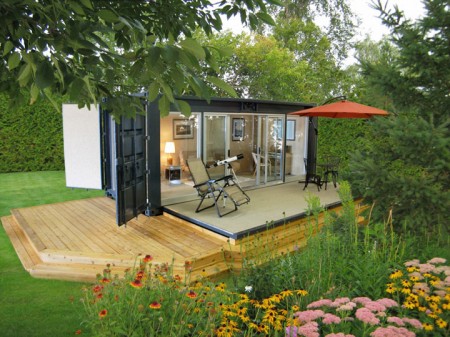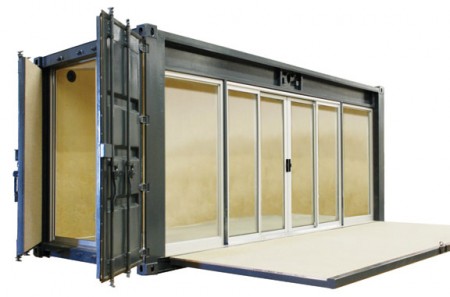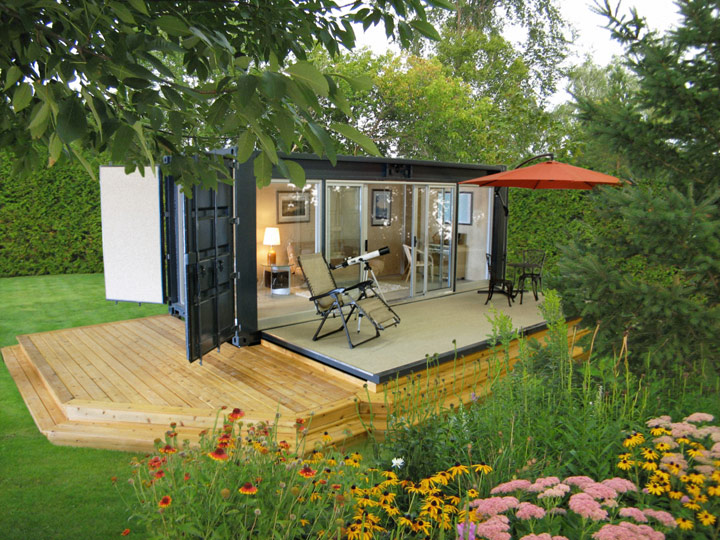Building houses from shipping containers is not new, but I think this might be the first company I have seen that builds smaller homes that are environmentally friendly and can be secured tight like a tiny little bunker.
Ecopods are built from recycled 8×20 steel shipping containers transformed into living, working and high end display spaces. The Ecopod is a transformed, designed built, multiple use, eco-friendly, building that promotes the best use of portability, off grid power supply capabilities and low environmental footprint.

The Toronto based company wanted to go even further with this ethos, so they incorporated rubber flooring recycled from shredded car tires into the design as well as an entire range of off-grid options including a solar-powered refrigerator, XM radio and 12V lighting and wall outlets powered from a roof-mounted solar panel. Even the composting toilet requires very little maintenance and costs a fraction of the traditional septic bed system. Download a PDF of the Ecopod brochure here.

Matthew Davies, the publicist for Ecopods.ca includes the following:
The ecopod started its life as a shipping container and traveled most likely half-way around the globe before being converted into the Ecopod. When the added hinged deck is raised the Ecopod maintains both the strength and proportions of its predecessor. It was our intention for the Ecopod to work ‘off grid’, although you can use it either way.
We first cut one twenty-foot side out of the shipping container and re-manufactured that steel wall into a deck that was then hinged back to the unit with six custom-designed offset hinges that allow the deck to lay flat and fit into its original position when closed. The deck is fairly heavy, so we engineered a 12V winch apparatus that has a lifting capacity of at least 4000lbs – its 12 volt battery takes its power from the solar panel. If you are leaving the Ecopod for an extended period of time, you can close the deck by flipping the electrical panel switch to supply the power to the 12 volt winch and the door closes by means of a handheld remote control. It takes about a minute to close and with the back doors locked, the pod is again returned to the form and strength of the original container.There is no conventionally-constructed building on the market that can compare to the strength and durability of the Ecopod.
Maintenance on the unit requires very little effort. The original steel walls and frame are made from a product called corten steel. Corten steel has a natural rust inhibitor that stops rust at the surface. The interior and exterior floor surfaces are covered with a product that looks very similar to cork flooring but is made from recycled car tires. This product has excellent interior and exterior performance qualities and is both impervious to water and easy to keep clean. The entire wall and ceiling cavities have been spray-foam insulated with the latest environmentally-friendly soya insulation available on the market today. It is a rigid ‘closed-cell’ insulation,’closed-cell’ meaning there is no moister transfer. All interior walls come clear-coat birch finished with a hidden fastening system and trimmed with aluminum. There are no visible mechanical fasteners in the wood finish. The front sliding glass doors and front glass side panels are double-glazed thermal pane units that allow you to enjoy all season weather conditions. We have equipped the pod with two electrical wall outlets that can supply power from the 12 volt battery through the inverter or are switchable to 120volts should you have access to either house or generator power. An 80 watt solar panel and 12 volt battery are included in the basic model.
Our intention was to give someone the option of enjoying a recreational property while creating a very low environmental footprint. The Ecopod can be used as a stand alone unit working off the grid or in conjunction with established building or cottage sites.
The Ecopod comes complete with all above-mentioned conveniences and finishes, all for a price of $26,650.00 CDN dollars.
What attracted me to the Ecopod was that it was not too expensive for a heavy duty self-contained space, and that you can completely close it up to protect it from animals, weather, vandalism and break-ins.
For Tiny House Blog readers who live in the Toronto area, you can view the Ecopod this month at the Green Living Show on April 24-26.
Photos by Ecopods
If you enjoyed this post, subscribe to our feed

I love it. Very secure for hurricane-prone areas. And just big enough.
Hi! I just want to say that I am now in love with ecopods 🙂 I have posted a link to your page on my site, http://www.faliaphotography.com. Thanks for the info, and I love your blog. Lots of wonderful information here.
$26k seems like a decent price, assuming that including integration with the composting toilet and solar panel and all that. I’d love to have one of these!
I think the Ecopod could provide a more enviro friendly alternative to manufactured steel/plastic/cement/synthetic small homes. That being said, Soy in Brazil is known to cost deforestation of rainforest land. People should be aware that supporting Soy can mean supporting deforestation of rainforests, where rainforest and agriculture are in competition due to the pressures of a relentless economy. Unfortunately, Soy is missrepresented/greenwashed by less than accurate marketers. That being said, I think your product idea and execution overall is generally good, due to the re-use of containers. The most green friendly small home you can build is accomplished with locally sourced plant/wood, especially repurposed.
Ecopods are a great ideea of green houses and at a pretty reasonable price seems like a very good option
do you guys have a number or what ??? Hello anyone home
@Tom – There are several of these EcoPod manufacturers in the USA as well, but the Canadian one Christina wrote about above is here: http://ecopods.ca
8 foot wide is like living in a hallway.. Great Idea on the security..
I recently lived in a room that was about 18 feet by 10 feet wide here in Los Angeles, and paid about $800 for that pleasure a month. On top of that, my only door was a glass door. I could live the same way and save thousands over the years…plus I could probably find someone up here in surrounding city that would let me “park it” there…or go up north…
I went to the website of the Green Living Show on April 24-26. the date on the web site was March 27-29. Sad I missed it.